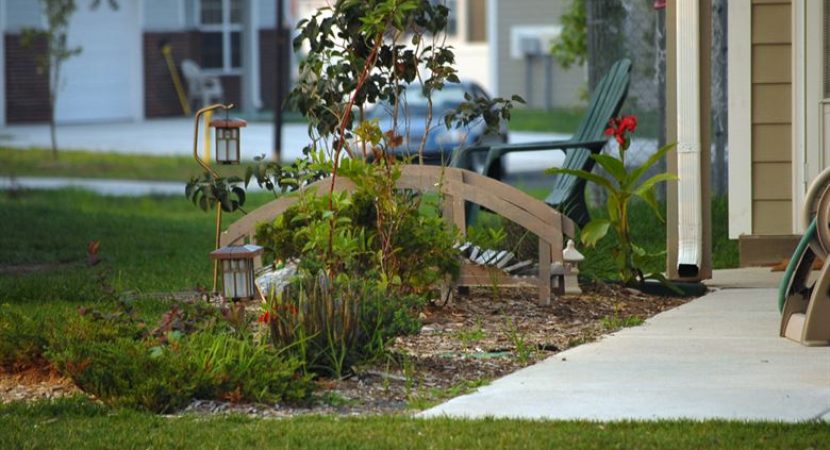Last Updated on
Soil erosion can be one of the most devastating and difficult problems to control on a sloping yard or piece of land. For homeowners and property owners, eroding soil can potentially ruin a beautiful lawn, driveway, garden, or landscape over time. Not only does soil erosion strip the topsoil of rich nutrients, which is essential for plant growth, but it can also lead to poor grass growth, unsightly runoffs, and even minor landslides.
The reasons behind soil erosion can be far and wide, ranging from cycles of flooding and aridity, or certain manual activities like large-scale construction or over-farming a sloping area. Fortunately, there are several ways to help control erosion, some offering short-term fixes and others being more long term solutions.
Apply a Layer of Quality Mulch
While not always an option depending on the type of lawn or property, one simple measure that can be taken at first signs of erosion is to apply generous layer of mulch, and preferable a high-quality, biodegradable option. These mulches will ensure that the symptoms of sudden and heavy rainfalls are lessened, as they form a protective layer above the valuable topsoil and they help prevent this layer from being washed away.
At the same time, many types of mulch can help soil retain its natural humidity while supplying additional nutrients. In addition to preventing soil erosion, a healthy layer of mulch can help a damaged area recover from damage done previously.
Reinforce with Retaining Walls
Yards with steeper slopes can be prone to more prominent forms of erosion. Sometimes, these drastic measures call for greater reinforcement, such as building retaining walls, terraces, or the structures that help segment and strengthen the yard’s integrity.
Turning a steep slope into a multilevel yard can also support the space for new plants and landscapes. Retaining walls can be enhanced by rigid materials like bricks, block pavers and large stones that act as supports and ensure the rigidness of the construction even when facing adverse weather.
Layer with Geotextile Fabrics and Netting
Geotextiles are another solution that can be applied in many cases of erosion, as they have numerous benefits and can often help solve the problem altogether. These products, which range from porous fabrics to containment netting products, are ideally applied beneath a layer of compost or mulch to ensure that the soil beneath receives adequate humidity. At the same time certain geotextile materials can help the drainage of excess water. Additionally, they also allow the soil to breathe naturally and keep everything together to prevent erosion.
Strengthen Soil with Plants
While oftentimes a more extensive solution, planting trees, shrubs, grasses, flowers, and other plants is another effective means to prevent soil erosion, as their root systems can act as a natural reinforcement against erosion. At the same time, new plants can help soil retain and recycle its nutrients more effectively.
While some homeowners like the idea of designing a sloping garden, an alternative route is to plant common grasses that will form an initial protective layer. During this process, you can start planning where to plant larger trees, shrubs, or bushes with a more rigid root structure. This combination, when effectively achieved, can be the optimal solution to control erosion issues long-term.
There are grass, shrubs and tree varieties that will cover any possible climate and situation. Consulting trusted local landscaping professional or agronomist is oftentimes a good investment to understand which plants are ideal according to the specifications and climate of your area. The last thing you want to do is invest in outdoor plants that are not conducive to your region, or preventing the erosion in the first place.
Get to the Root Cause
As a final piece of advice to help prevent soil erosion from destroying your yard or property, get to the root cause of the erosion problem itself. In many cases, these erosion problems are caused by uncontrollable factors like long rainy seasons or sandy topsoil, but it’s also common that the erosion is caused by certain dips or low spots that experience heavy flooding, problematic runoff slopes, or creeks and streams running through the property.
In some cases, you can try controlling eroding soil by artificially diverting the flow of water with well-designed trenches, slowing the flow of water with dams and diversions, or forming a better drainage system that will ease the intensity of water flow and erosion. Since such work can be laborious and costly, it should preferably be done in collaboration with the local community, as such a problem will affect an entire area sooner or later and never just one property.
Final Thoughts on Stabilizing Soil
The main difficulty when facing erosion problems in your property is that it’s usually a multifaceted problem with numerous causes and hard to diagnose immediately. Erosion can start slow and progressively accelerate, soon getting out of control. It’s crucial to act fast and decisively in order to solve it before it becomes impossible to do so.
Instead of considering the tips above as separate ideas, view them as parts of a combined approach which is essential if you want to have good results. It is a problem that demands both short-term actions, as well as carefully planned long-term strategies help guarantee that it will not reappear.


Reply